Posts in Category: Uncategorized
Where should special-needs kids be special? by Amy S.F. Lutz
 A friend of mine saved this article for me to read. He thought it pertained well to our family’s situation. I couldn’t agree more. I never realized how much I weighed this issue in my own mind — I even went so far as to GET A SERVICE DOG for my son to improve our ease in the environment. I think that Ms. Lutz sums up my thoughts perfectly:
A friend of mine saved this article for me to read. He thought it pertained well to our family’s situation. I couldn’t agree more. I never realized how much I weighed this issue in my own mind — I even went so far as to GET A SERVICE DOG for my son to improve our ease in the environment. I think that Ms. Lutz sums up my thoughts perfectly:
Where Should Special Needs Kids Be Special?
Tricky questions about how to share public spaces.
By Amy S.F. Lutz
Earlier this year, I was out to dinner with a friend and our combined eight kids. My 14-year-old son, Jonah, who has autism, was very excited about the imminent arrival of his hamburger and french fries, so he was acting as he does when he’s happy: bouncing in his seat, clapping his hands, and vocalizing a mishmash of squawks and catchphrases from his favorite Sesame Street videos. He wasn’t exceedingly loud, but the oddness of his behavior had clearly caught the attention of an older gentleman at the one other table occupied at that early hour.
“Shhhhhhh,” he hissed from across the room.
Everyone at the table instantly froze—except, of course, for Jonah. “I’m sorry,” I explained, rising from my seat and taking a few steps toward him so I wouldn’t have to holler. “My son is autistic … ”
“Oh, sorry,” he said.
“He’s not trying to disturb you intentionally … ”
“I heard you the first time,” he snapped.
My face burned as I returned to my seat, his gratuitous nastiness instantly draining the joy from my evening. I spent the rest of the dinner constantly shushing Jonah, even though we had specifically decided to eat out at 6 on a Thursday night in a casual eatery so we wouldn’t have to hold any of the kids to impossible standards of behavior.
It turns out my friend and I weren’t the only ones who have been discussing the rights of disabled individuals in the community, the responsibilities of their families, and the expectations of the public, as we did that evening. Two recent high-profile incidents focused the nation’s attention on this very issue.
First, Whole Foods faced the ire of the autism community after a contracted security guard at a Milwaukee grocery allegedly told the sister of a 26-year-old autistic man who had taken some food from the hot bar that “he needed to get out of the store and not come back “unless he was on a leash.” Although the guard resigned, Whole Foods apologized, and sensitivity training was arranged for the entire staff, a spokesperson gently pointed out this wasn’t the first time Michael Goldman had helped himself from the prepared trays. Even if his sister paid for the food, as she offered to do, it’s unclear what expenses the store might have had to absorb if Goldman had used his hands, contaminating the entire tray. As the parent of an autistic teen who is also a threat to snatch food, I wondered along with many others why his sister hadn’t been glued to his side—or even, as I would have been, physically guiding him by the arm or shoulder—in such a tempting environment.
The next week, Michael Garcia, a waiter at a Houston restaurant called Lorenzo’s, received mass acclaim after refusing to serve a family who changed tables to get away from a 5-year-old with Down syndrome. The customer allegedly complained to Garcia that “special needs children need to be special somewhere else.”
To sum up the fallout from these incidents: It’s not OK to be offended by the sight of disabled people in the community or to insult them or their family members. However, neither is it OK for anyone, disabled or not, to engage in dangerous, illegal, and/or unsanitary behaviors.
Pretty broad parameters, no doubt, but hopefully ones we can all agree on.
Where it gets tricky is in the middle. What are reasonable expectations of behavior in public places? Like many autistic individuals, Jonah is virtually incapable of doing anything quietly. He has been scowled at on airplanes, in movie theaters, in restaurants, and in bookstores. And I get it—I prefer a quiet airplane ride as much as the next person. But what I keep coming back to is that community, by definition, is inclusive. Ideally, our public spaces should accommodate everyone. Which means that expecting kids like Jonah to just stay home isn’t reasonable. Nor should we think of this issue in terms of what discomfort or awkwardness people without disabilities are willing to tolerate, because that suggests a troubling hierarchy of privilege. Instead, we need to ask ourselves how best to share our common facilities.
As anyone who’s ever parented young children knows, there are two ways of sharing: taking turns or using something together. Turn-taking seems to be particularly in vogue of late, at least when it comes to autistic people in the community: Zoos, amusement parks, bowling alleys, roller skating rinks, movie theaters and purveyors of just about any type of entertainment imaginable are setting aside time particularly for individuals with autism and their families. These are fabulous programs that allow autistic children to have fun and try new activities. They also take the pressure off parents, who don’t have to worry their kids are being too loud or just too weird—because I think it’s often the strangeness of autistic behavior that disturbs people, not simply the volume. My four younger kids have done their share of enthusiastic joking and singing in restaurants and other public spaces, but no one has questioned the appropriateness of their presence as some have done after observing Jonah chant, “Mommy Aunt Keri with a Daddy song” while wiggling his fingers in front of his face until he goes cross-eyed.
There’s no question that separation makes things easier for everyone. After another older patron at the same establishment complained on a different night about Jonah watching his touch-screen device while waiting for his dinner, we permanently moved our group into a party room apart from the main dining room. I’m finally able to relax—we don’t have to make Jonah stay in his seat or constantly remind the seven other kids to use their “indoor voices.” Philosophically, however, it bothers me: What are my children, and my friend’s children, learning about the place of the disabled in the community? Will they grow up thinking it’s perfectly natural for people like Jonah to literally be shunted into a back room?
So I guess I prefer the messier way of sharing, where everyone’s in it together. This is typically what occurs, and typically it works out: We, the parents of potentially disruptive kids like Jonah, generally don’t take them to the ballet or other live performances that require quiet audiences. We take them to movies that have already been out for weeks, and we go at off times. Instead of going to the Four Seasons on Valentine’s Day, we take them to family-friendly restaurants where, honestly, it’s unreasonable for anyone to expect much ambience.
And most people are pretty accepting. They’re busy with their own affairs, for the most part. Even if they do notice us, they know it’s rude to stare, and I’ve actually caught several parents surreptitiously using us as a teaching moment to explain to their kids why they shouldn’t point. When Jonah bumps into strangers while he’s spinning, they usually accept our apologies and move on without making a big deal out of it. While there are obviously still those who feel that autistic children belong “on a leash,” I think there are more who want to help—people who let us step in front of them in line at Wendy’s, for example, because they know that waiting can be extremely difficult for kids in this population. And I have to say, there’s no charitable gesture I can think of that beats, in terms of pure value, letting a family with a child with autism or a similar disability cut in line. It costs only a few minutes of your time, but it can make a tremendous difference for that family, who may have been forced to leave—without their lunch, or their groceries, or even their turn down the waterslide—because of their child’s increasing agitation.
When the public routinely encounters disabled individuals in the community—sees them running the same errands, enjoying the same activities, and yes, even struggling with things that come easily for others, you get the level of compassion shown in an April 2012 segment of ABC’s “What Would You Do?” In the hidden-camera video patrons of a New Jersey restaurant universally supported the family of an autistic teen (all played by actors) against a single diner (also an actor) who was offended by the teenager’s disruptive behavior. What had me sobbing in front of my computer was that even when the actor playing the autistic boy actually snatched french fries off the man’s plate, the other diners rallied behind the family, comforted the parents, and applauded when the man stormed out.
I don’t expect that much acceptance. But I think we can do better than “I heard you the first time.”
My radio debut
As I mentioned in my last post, April is Autism Awareness Month. I’m not sure how bad a disorder has to get to warrant a whole month of awareness, but the newest statistics reveal that 1 in 50 children is being diagnosed with autism. That’s pretty alarming. At this point, we need more than awareness: we need a plan. I’m not sure why this hasn’t become a national crisis in the eyes of the government. If medical costs are making the national debt increase, then hold on to your hat because these kids are EXPENSIVE. Additionally, I am distraught at the lack of a plan for this kids long-term as they become adults. What will happen when 2% of our adult population needs long-term care? For now, I will settle for awareness with the hopes that it will aid in provoking a solution from people who are more equipped than me.
Awareness is a pretty broad topic. I think that the public is pretty “aware” that there is a situation on our hands. I think that is happening purely by the fact that, nowadays, pretty much everyone knows someone who has autism. In fact, when I talk to friends and acquaintances, it is pretty common for them to identify more than one person in their family or circle of friends who has a child with autism. The problem is that most parents are either too ashamed or too overwhelmed to be able to explain exactly what they are dealing with. I, on the other hand, have been blessed with a lack of shame and a compulsion to share my story with anyone who will listen. As I have been talking with people and getting feedback on this blog, the one comment I keep getting is, “I had no idea how difficult your life was on a day-to-day basis.” I have to admit that this comment surprised me. I really thought that I was doing a good job explaining our life with Gray so that people understood what we go through. Now, I realize that I often glossed over the gory details in an effort to prevent people from being uncomfortable and to make my life seem more “normal.” I guess, in a social setting, it is hard to get that message across. I mean, when you are out to dinner with friends and people start sharing stories about their kids, it’s kind of a buzz-kill to chime in with, “My kid ran out the front door naked today and started running towards the 4-lane road that is a block away from our house!” So, while I may continue to spare my dinner companions alarming stories like that, I will write about it and speak about it and do my best to explain it in a way that people can understand. If we want the public and lawmakers to be sympathetic and take action on our behalf, we must paint a detailed and accurate picture of the struggle that our children experience.
I also want people to know about autism service dogs and the amazing gifts they can give a family like ours. If someone reads my blog and decides that their family could benefit the way ours has, then I will be beyond thrilled. Last year, I went to a lecture where a man who is visually impaired described his experience with his service dog. He spoke about receiving his dog when he was in college and remembered the first time he walked across the campus without fear of being hit in the face by a branch or being caught off guard by a traffic light. He spoke about the incredible freedom his dog gave him to explore the world without being so vulnerable. I remember being moved by his story. I had no idea that Gray’s story would be so similar. I can honestly say that Hope is a guide for Gray that lets him explore his world while keeping him safe. In addition, she is an anchor that keeps Gray secure in knowing where he is supposed to be.
So, in the spirit of raising awareness, a radio station in Seattle asked ASDA if Kati could speak about their program and include a parent of a child with a service dog. Guess who got to make a radio debut???
Saturday Solo
 Let me start with a little disclosure: I have lots of help. During the week, I have a nanny that helps keep my house in order and shares the duties of shuttling my 3 kids around to various activities and therapies. On the weekends, I have had a person who will work with Gray or join us for family outings so that there is an extra set of adult hands. Unfortunately, this person recently relocated to another state and I have not been able to find the perfect replacement yet. Because Barry’s job has been so demanding and stressful lately, he has been working 7 days a week for months. That left me on my own last weekend with 3 kids to entertain.
Let me start with a little disclosure: I have lots of help. During the week, I have a nanny that helps keep my house in order and shares the duties of shuttling my 3 kids around to various activities and therapies. On the weekends, I have had a person who will work with Gray or join us for family outings so that there is an extra set of adult hands. Unfortunately, this person recently relocated to another state and I have not been able to find the perfect replacement yet. Because Barry’s job has been so demanding and stressful lately, he has been working 7 days a week for months. That left me on my own last weekend with 3 kids to entertain.
April is Autism Awareness month. That means that lots of organizations are doing autism-friendly events for families. This past Saturday, the Dallas Museum of Art put on a morning program for kids with autism and their siblings. I decided that an event like this would be my best bet for keeping all of the kids entertained in an environment where people would be understanding.
As we pulled up to the museum, I told Zoe that I was feeling nervous and I really needed her to be a helpful big sister. She said she was ready for the challenge. It turns out that I didn’t need her help at all. The event was lovely. There were craft rooms for the kids, a sketching station with a sculpture as a model, a sensory area and 2 different musical presentations. Gray was not too interested in the craft areas, but the girls really enjoyed them while Gray, Hope and I just walked around peacefully and enjoyed the sights. When it was time for the musical presentation, we all filed outside and sat nicely in the sunshine while we listened to a violin performance. Many parents asked me about Hope and how she is helping Gray. It made me think that I really need to get business cards so that people can read about the two of them here on this website.
As the program was wrapping up, I told the girls we could go out to lunch somewhere. We have become total pros at casual restaurants and I felt sure that Hope and I could handle these kids in a pizza place or somewhere similar. As we left the museum, we exited the building in front of our new downtown park. Food trucks lined the street with a children’s play area just beyond them. Zoe immediately asked if we could have our lunch at the food trucks and then stay at the park for a while. Feeling bolstered by the smooth morning, I told her that we could try, but I really didn’t know how it would turn out. With great ease, we walked to the corner, waited for the light to change and crossed the street to the park. After we identified a food truck that we all liked, we got in line. Gray tried to make a run for the front of the line, but Hope’s tether kept him close and bought me enough time to pull out his iPad and explain that we had to wait in line to get hamburgers. Unbelievably, this satisfied him and he waited with me (head buried in my hip) for almost 15 minutes while the girls played games nearby. Zoe proved to be an excellent waitress as she helped me carry everyone’s lunch to a little table. We settled in, I tied Hope’s leash to the tree next to Gray’s chair and we all enjoyed the beautiful weather and lunch. I kept looking around at everyone else in the park and I wanted to shout, “Hey, look at me! I’m eating my lunch in a public place with my kids and I have BOTH hands free! Look, my son is sitting all by himself!”
After lunch, the kids played on the playground for another hour or so and we headed home. As we drove out of the parking lot, Zoe beamed about what a fun day we had. I agreed. “We did it, Zoe! We don’t need a babysitter or therapist to come with us. We have got this down!”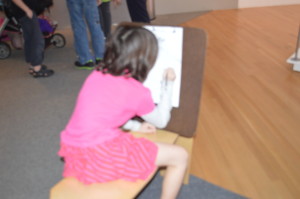

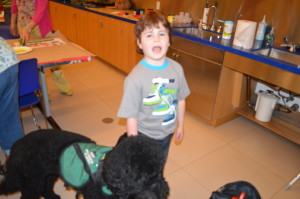

August is almost here!
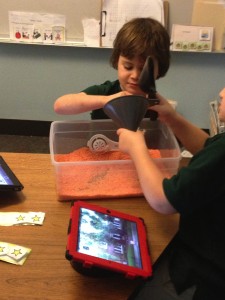 Every year around this time, I have to start thinking about how Gray will spend his summer and what school will look like for next year. It’s a difficult process because there are not a lot of options for kids like Gray. This year, we worked with a private school for children with learning differences to create a pilot program for kids who use iPads to communicate. This program has been really wonderful for Gray because of the talented teacher that leads his class and the other committed professionals who help things run smoothly.
Every year around this time, I have to start thinking about how Gray will spend his summer and what school will look like for next year. It’s a difficult process because there are not a lot of options for kids like Gray. This year, we worked with a private school for children with learning differences to create a pilot program for kids who use iPads to communicate. This program has been really wonderful for Gray because of the talented teacher that leads his class and the other committed professionals who help things run smoothly.
The focus in his class is on all learning happening through use of the iPad so that Gray and the other student in his class can unlock the power of communication beyond just asking for french fries. In order to make this happen, we have 1 teacher and 1 aide, an occupational therapist who sees each kid once a week, a physical therapist who sees each kid once a week, a behavioral therapist who observes and consults, and a speech therapist who specializes in augmentative communication devices that spends a whole day with the class once a week. As you can imagine, this program is expensive. Additionally, the school that Gray attends is not a school that was designed for children with autism. His school was founded to help children with learning differences, but it is not equipped to deal with the kind of behavioral issues that Gray brings to the table. The day that I arrived to pick him up and found him laying in the hall screaming while his teacher tried to keep him from injuring himself was the day that I knew his needs were starting to encroach on the needs of everyone else in the building. When you put together the cost of the program and Gray’s behavioral challenges, the school understandably decided to discontinue the program for next year.
So, I went back to the drawing board. After considering the limited school options for Gray, I have decided to give public school a try. I won’t lie. I am desperately afraid of how this will go. I have had many friends who have worked as therapists in the public schools and they all report that they feel inadequate in the care they can provide to special needs students due to limited resources. The one glimmer of hope is that, in the public schools, the squeaky wheel gets the grease…and I am an excellent squeaker. In the meetings to set up Gray’s Individual Education Plan (IEP), I made sure that I was very clear in expressing Gray’s level of disability and I was able to get them to approve a private aide for him in the classroom. Additionally, the teacher for his future classroom seems truly committed to her job and she has given me several examples of how she runs her classroom that make me believe she understands kids like Gray.
I pray that, with me as his advocate, Gray will have resources available to him that a small private school cannot provide. I pray that the district administrators will be able to understand the benefits that Hope can give to Gray. And, I pray that Gray will continue to thrive in yet another new environment.
There is no auto-pilot for the mother of a child with autism!
Practicing manners
 Last Sunday night, we were invited to dinner at a friend’s house. I reluctantly accepted the invitation after she assured me that there was nothing Gray could do that would mess up her house. I respectfully disagreed, but I thanked her for believing in us and told her we would come. In reality, I was thrilled with the invitation. As I have mentioned before, we are rarely invited as a group to friends’ houses. Over the years, I have declined enough offers and looked significantly disheveled after the offers we did accept that people have just given up putting me in that position. Also, as our children get older, people have a lower tolerance for destruction, screaming and poop accidents. It’s just easier to have people at my house, but truthfully, we don’t do that terribly often either.
Last Sunday night, we were invited to dinner at a friend’s house. I reluctantly accepted the invitation after she assured me that there was nothing Gray could do that would mess up her house. I respectfully disagreed, but I thanked her for believing in us and told her we would come. In reality, I was thrilled with the invitation. As I have mentioned before, we are rarely invited as a group to friends’ houses. Over the years, I have declined enough offers and looked significantly disheveled after the offers we did accept that people have just given up putting me in that position. Also, as our children get older, people have a lower tolerance for destruction, screaming and poop accidents. It’s just easier to have people at my house, but truthfully, we don’t do that terribly often either.
I felt so hopeful that the evening would go well. In my fantasy world, where we have a normal life, there are lots of evenings and weekends where we just hang out with other families and chat while the kids play. I really had let go of that until Hope came along. In reality, there is not anything that Hope can do for Gray once we are at someone’s house. She’s there to walk him in and out, but after that, he is on his own. I think the biggest change has been in my attitude towards Gray and what I can expect of him.
Temple Grandin (one of the country’s most accomplished and celebrated people with autism) has often said that she credits her mother with her success as an adult. She says that good manners were required at her house growing up. Of course, Gray is more severely affected than Ms. Grandin. I have always told myself that good manners were way beyond what I could expect of Gray. After all, how do you teach a typical child manners? Through explanation, reminders, scolding and discipline. Gray doesn’t respond to any of those things. How to teach him something as gentile as good manners when he can’t understand the concept?
Through Gray’s wonderful behavioral therapists, I have learned that there is another way: shaping behavior. Unfortunately, it takes exponentally longer than just teaching a typical child, it still works. It just takes mountains of time and patience. Because you cannot explain things to Gray or give him detailed instructions, you have to just take him through the motions of any given task or scenario hundreds of times until he learns that pattern. For example, many small children like to get up and wander away from the table during meals. Gray is no exception…except his wandering looks more like crazy running and jumping and squealing. Getting Gray to learn to sit at the table has taken about 2 years of concentrated effort. Everyone who works with Gray finds an opportunity to make him sit at the table to eat. Through a combination of preventing him from getting up and providing immediate rewards for staying seated, his behavior has been shaped so that he can now sit at the table at home for meals.
Hope has strengthened this behavior by letting us carry it out into the community. Now, Gray is able to generalize all meals to a table. By witnessing Gray’s ability to respond to this kind of behavior shaping, I have grown more confident in my ability to make good manners a priority. Some people might ask me why I care about something as shallow as manners when we have so many larger deficits to conquer. I would respond that friends, family and the general public will be a lot more understanding and willing to accommodate a kid like Gray if he has good manners.
The evening at our friend’s house went relatively well. Fortunately, all guests present were well aware of Gray’s “quirks” and no one got too alarmed when he pinched a couple of people and pulled someone’s hair. Most people would consider that disastrous, but I tried to look at all of the areas where he has grown. With a coffee table full of books and a side table full of pretty collectibles, Gray was able to leave the living room relatively undisturbed. Although, he kept circling the appetizer table taking bites out of crackers and returning them to the serving dish, when the dinner was served, he walked over to the dining table, selected a seat, pulled out the chair and sat down. Although I had to bring a dinner from home that I knew he would like, he stayed in his seat and quietly participated in dinner with everyone else. It is notable to point out that I was able to finish my entire dinner and carry on a conversation without having to get up once or apologize for any crazy behavior.
Was it perfect? No. Was it all that I hoped it would be? Yes. I see now that Gray has made huge strides in civility and his ability to display his new skills outside of our home. Now we just need a few hundred dinner invitations to practice. Any takers???
Shabbat
Lena goes to a Jewish preschool that is part of our synagogue. Every Friday, they begin their school day with an assembly to celebrate Shabbat. It is a lovely experience with singing, candle lighting, blessings and birthday celebrations. I try my best to go and sit with her class after I drop Gray off at school on Fridays. This past Friday, Gray did not have school, so I decided to try and take him along.
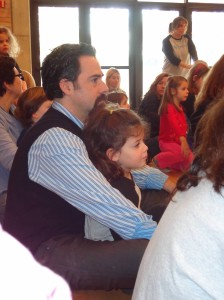 Generally, when I take Lena to school, I leave Gray and Hope in the car in the front driveway of the building because Gray gets so excited/overstimulated in a preschool setting. He generally comes bursting in the classroom and begins his tornado-style assault on the toys, books and other children. Puzzle pieces fly, pages are chewed and torn and hair is pulled. It can be a mess untangling him from the chaos and he generally gets very upset when we have to leave quickly. But, today, we could stay and enjoy Shabbat and I felt confident that he would enjoy it.
Generally, when I take Lena to school, I leave Gray and Hope in the car in the front driveway of the building because Gray gets so excited/overstimulated in a preschool setting. He generally comes bursting in the classroom and begins his tornado-style assault on the toys, books and other children. Puzzle pieces fly, pages are chewed and torn and hair is pulled. It can be a mess untangling him from the chaos and he generally gets very upset when we have to leave quickly. But, today, we could stay and enjoy Shabbat and I felt confident that he would enjoy it.
When we arrived in Lena’s classroom, he immediately let go of Hope’s handle and started pulling towards the enticing items around the room. Fortunately, the tether did not let him go very far. I told him that he needed to grab his handle so we could move on to Shabbat, and he complied with only a little protest. As we walked down the hallway, he strolled nicely by my side and reached for Lena’s hand so that he could walk with her. After entering the noisy music-filled sanctuary, he took a little time to select the perfect seat before settling in nicely. It was such a pleasant time with him moving from his chair to my lap to Lena’s chair as he clamored to get the best view of the action at the front. It wasn’t at all manic, it was just happy and engaged. About 15 minutes in, he climbed on my lap facing me and threw his arms around my neck. He had the brightest smile on his face as he pressed his lips onto mine so hard that I had to brace myself.
When it was time to take the children back to the classrooms, we walked with Lena’s class through two lines of teachers who were singing and clapping and shaking tambourines. Instead of getting revved up like I expected, he just grinned up at them and kept pace with the other kids. As I looked around and witnessed the scene, all I could think was, “He looks just like the other kids right now and he is loving it!” That’s when I got emotional. He is not at all like the other kids, but I will revel in the brief moments when we can feel that way.
Yoga lessons from Gray Golden
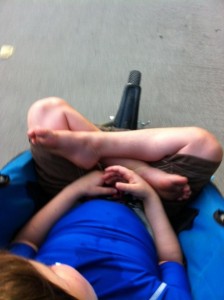 Barry and I consider yoga to be a big part of our lives. I have been attending classes 3-4 times per week for over 3 years and I feel like it has changed my life. Not only is it a great way to build strength and endurance, it is also an amazing way to view the world. The basic premise of yoga is to focus on the present moment. Whether it is joyful or painful, it is important to stop and observe what you are feeling in the moment and experience it. Yoga provides the wisdom to know that each moment is transient. If you let your past experiences or future plans take over your thoughts (like most of us do) you will miss what is right before you. I believe that this is an attitude we all should aspire to.
Barry and I consider yoga to be a big part of our lives. I have been attending classes 3-4 times per week for over 3 years and I feel like it has changed my life. Not only is it a great way to build strength and endurance, it is also an amazing way to view the world. The basic premise of yoga is to focus on the present moment. Whether it is joyful or painful, it is important to stop and observe what you are feeling in the moment and experience it. Yoga provides the wisdom to know that each moment is transient. If you let your past experiences or future plans take over your thoughts (like most of us do) you will miss what is right before you. I believe that this is an attitude we all should aspire to.
For Gray (and many children with autism), this is not an aspiration. This is a reality. From a very young age, Gray has naturally assumed yoga postures. At any given moment, he might be sitting in full lotus or stretching in a downward dog, or kicking up into a handstand preparation. I believe that something inside of him knows when he needs to experience the sensation of these postures and his flexible little body just goes there. Gray does not plan for the future and he does not dwell in the past. He just is. Right here. In the present.
When Zoe lost her first tooth, it was a very stressful experience. She would alternate between excitement and panic. She would wiggle the tooth and light up with hope that it might come out and then she would get hysterical if there was any blood or pain. For days, it consumed her. What would happen? Would it be disgusting? Would buckets of blood poor out of her mouth? Would the tooth fairy bring a fortune? Our whole house was on-edge waiting for the big moment.
When Gray lost his first tooth, it was a very different experience. First, it was wiggly, then it was VERY wiggly. He would push at it with his tongue or touch it with his fingers, but his interest was short-lived and the prospect of a wiggly tooth didn’t concern him much. He had no fear or expectation attached to the event, it was just a new situation and sensation that he noticed and moved on. Eventually, it just got so wiggly, it fell out during lunch. He calmly handed the tooth to me and kept on eating. There was no blood and no drama. It made me think about how often we make events so much more stressful than they need to be. How many situations have fallen short of our expectations, both good and bad? The planning and excitement for some fabulous event falls short. The anxiety and the hand-wringing for some unpleasant event turns out to be unwarranted.
We all encounter situations that we have no control over. We often make ourselves crazy trying to DO something or calculate our reactions. We could all benefit from a little less struggling. A little less planning. Just observing and experiencing. This moment will pass. In the meantime, just BREATHE!
About Hope
 Hope was born on September 19, 2010. She came to us about 4 months after she turned 2. At 8 weeks of age, she started her training to be a service dog. This included basic obedience training and socialization so that she would be comfortable out in the community. Of course, I cannot speak to the details of her training because I am not a trainer and, frankly, I don’t need all the details. My point in bringing this up is to say that Hope has spent her entire life training for the job she has now. People often ask me if their pets can be trained to be a service dog. My answer is, “Probably not. The training has to start from early puppyhood.”
Hope was born on September 19, 2010. She came to us about 4 months after she turned 2. At 8 weeks of age, she started her training to be a service dog. This included basic obedience training and socialization so that she would be comfortable out in the community. Of course, I cannot speak to the details of her training because I am not a trainer and, frankly, I don’t need all the details. My point in bringing this up is to say that Hope has spent her entire life training for the job she has now. People often ask me if their pets can be trained to be a service dog. My answer is, “Probably not. The training has to start from early puppyhood.”
Also, let me clarify terminology: Hope is a service dog. That is different than a therapy dog. A service dog is meant to guide and assist a person with a disability to navigate the environment at home and in the community. A service dog is a highly trained animal that is allowed by federal and state laws in any public place. They are assigned to one individual for their role as a lifetime assistant to the person with the disability. A therapy dog is meant to assist with emotional or psychological stress associated with disability or trauma. These animals help patients work towards specific physical, social, cognitive or emotional goals. A therapy dog is not usually assigned to just one person. They generally work in facilities like hospitals, nursing homes, schools or psychiatric offices to help many patients. If you have a well-trained pet with a very calm demeanor, this kind of full-grown dog can be trained to be a therapy dog.
During her training, Hope learned the difference between the times when she has her service pack on and when it is off. When her service pack is on, she is on the job. She knows this and will always exhibit exceptional behavior as well as a rock-solid calm demeanor. She is not distracted by other animals or food and she remains focused on her boy at all times. She knows her job and she takes it seriously. But, when her pack comes off, she is just a well-trained house pet. She runs around the yard, barks at squirrels, plays with the kids or other dogs and loves chewing on bones while she relaxes on her dog bed. It is important for us, as a family, to help find the balance between giving her “time off from work” and still remaining calm to maintain her calm demeanor. That is a challenge in my household, but we are working on it.
When she is wearing her service pack, no one is allowed to pet her besides Gray or the adult who is her handler. This is a hard one for people to understand. I hate telling people “no” when they ask to pet her. I especially hate telling people to stop when they have already touched her without my permission. I do it anyway, though. It’s important to keep her focused on her job. I tell people, “how well could you do your job or school work while a stranger patted you on the head?” I hate to appear rude, but I’ll be damned if I will let an eager dog-lover ruin the very expensive and time consuming training that she has mastered.
We did not name Hope. ASDA received puppies in groups from various breeders. Each group of puppies are roughly the same age and start training at the same time. This allows ASDA to hold regular training sessions for the puppy raisers that will be relevant to everyone at the same time. In order to keep the groups straight, ASDA names the puppies in alphabetical order so that all of the dogs in the group have names that start with the same letter. Hope was part of the “H” class. It is pure serendipity that we received a dog with such an appropriate name. We could have just as easily ended up with Heidi, or Hazel, or Haley or Hunter. But, we didn’t. We got Hope. The perfect dog for Gray.
First trip to the movies
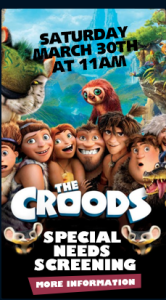 Studio Movie Grill here in Dallas is one of my favorite movie theaters. It is a place where you can sit at a table or counter and order a meal while you watch your movie. I love seeing movies there and I especially love the company because they do a “special needs screening” whenever a new kid movie comes out. Usually, the second Saturday after the movie opens, they will have a showing at 11am for kids with special needs. The kid with special needs and their siblings are free and anyone accompanying them is just $6. During their special needs screening, they only lower the lights halfway and they bring the sounds levels down to help out kids with sensory defensiveness. Also, the rules of civility are not as strictly enforced so that parents can feel less distraught if their child has a meltdown or can’t stay in their seat. That says a lot about this company. Any company that puts that much thought into the needs of their community and takes into account the financial stress of caring for a special needs child deserves my support.
Studio Movie Grill here in Dallas is one of my favorite movie theaters. It is a place where you can sit at a table or counter and order a meal while you watch your movie. I love seeing movies there and I especially love the company because they do a “special needs screening” whenever a new kid movie comes out. Usually, the second Saturday after the movie opens, they will have a showing at 11am for kids with special needs. The kid with special needs and their siblings are free and anyone accompanying them is just $6. During their special needs screening, they only lower the lights halfway and they bring the sounds levels down to help out kids with sensory defensiveness. Also, the rules of civility are not as strictly enforced so that parents can feel less distraught if their child has a meltdown or can’t stay in their seat. That says a lot about this company. Any company that puts that much thought into the needs of their community and takes into account the financial stress of caring for a special needs child deserves my support.
But, we didn’t go to the special needs screening. The schedule didn’t work out for us and Gray was looking mellow, so I decided to just go for it.
Actually, the decision wasn’t quite that simple. I agonized a bit about making the right decision. On one hand, I knew that I would feel comfortable in the special needs screening. I knew that I wouldn’t have to apologize to anyone and our crazy crew would fit right in. On the other hand, I considered the fact that Gray is not defensive against sensory stimuli. He really enjoys stuff when it is loud and crazy. I also considered the fact that we are getting pretty good at outings now. Gray is clearly understanding that, when we go somewhere and there are chairs at a table, he should take a seat and remain there. I didn’t know if I might risk him learning some bad movie etiquette or set up expectations of movies always being semi-lit with soft sounds. I also didn’t know if the full-on movie experience might turn out so badly that he would develop an aversion to movies overall.
In the end, I decided that the risks were small and the possible payoff could be really big. Lena is just getting to the age where she likes to go to the movies. This was my shot to get a good rainy-day family activity on the menu for everyone to enjoy. Here’s what I did to make the trip as successful as possible:
1. We went to the first showing of the day. I figured that, special needs or not, anyone who is coming to this showing probably has young kids and does not expect perfect behavior.
2. This theater has reserved seating. I purchased tickets at the counter on the aisle. I figured a counter invites less squirming than a table and obviously the aisle allows for a fast getaway (just in case).
3. We arrived 10 minutes after the movie’s start time so that we missed the previews and were just taking our seats as the movie started. I actually think Gray wouldn’t mind the previews, but I wanted to keep the sitting time to an absolute minimum.
4. I brought extra snacks in my purse to keep him busy until the real food could arrive.
5. I tied him to a 50-pound dog so he couldn’t rush the screen or climb over the seats to assault other movie-goers. -Very important detail!
All I can say is, it was miraculous. I tried hard to keep my eyes on the screen so he would see what was expected. About 5 minutes into the movie, he looked over at Zoe and Lena (who were both watching the screen) and he looked at me (pretending to be watching the screen), and then he did the same. He sat nicely in his chair and ate his snacks and watched the movie. About 15 minutes before the end, he started playing with his iPad, and then he fell asleep on top of the iPad. Works for me!
Bring on the rainy days…we are ready.
Six Flags
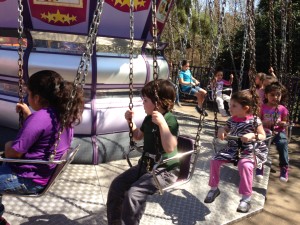

 The zoo went so well, I decided that we were ready for the big leagues. This morning, I decided that we were going to try Six Flags Over Texas! Because Gray is such a sensory seeker, I knew he would love the rides if I could just keep him from melting down or running away. In anticipation of Hope’s arrival, I bought memberships or season passes to several points of interest around town. I figured that would take the pressure off if we had a rough trip or wanted to end early to keep things from heading south. With a season pass, I don’t feel pressured to get the most out of my expensive ticket, I can just say, “That’s enough for today, we will try this again soon.”
The zoo went so well, I decided that we were ready for the big leagues. This morning, I decided that we were going to try Six Flags Over Texas! Because Gray is such a sensory seeker, I knew he would love the rides if I could just keep him from melting down or running away. In anticipation of Hope’s arrival, I bought memberships or season passes to several points of interest around town. I figured that would take the pressure off if we had a rough trip or wanted to end early to keep things from heading south. With a season pass, I don’t feel pressured to get the most out of my expensive ticket, I can just say, “That’s enough for today, we will try this again soon.”
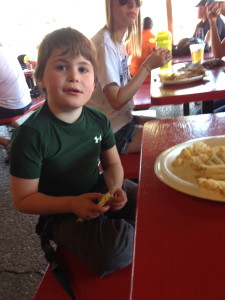 This week is the perfect week to try these adventures because Gray and Lena are on spring break, but Zoe is not. Of course, Zoe is fun to be around and she tries to be understanding of the limitations that surround her brother, but I knew that her normal 9-year-old needs would NOT be met on any of the outings we were taking with Gray this week. On the other hand, Lena is the perfect companion for Gray. She has a similar activity tolerance and energy level. Also, she is blissfully ignorant to anything that we might be “missing” by going on limited rides or leaving early. I have often thought, “Thank goodness for Lena.” She is an anchor that keeps me from feeling held back by Gray. Without her, I would constantly be mourning the lack of “big kid” stuff that we couldn’t do with Zoe. I would blame it on her brother and, I fear, she would blame it on her brother as well. With Lena, we are brought back to the activities and tolerance of a normal 3-year-old level (which is a level much more suitable to Gray). That way, any big kid stuff that Zoe misses can be blamed on her little sister. That seems healthier to me!
This week is the perfect week to try these adventures because Gray and Lena are on spring break, but Zoe is not. Of course, Zoe is fun to be around and she tries to be understanding of the limitations that surround her brother, but I knew that her normal 9-year-old needs would NOT be met on any of the outings we were taking with Gray this week. On the other hand, Lena is the perfect companion for Gray. She has a similar activity tolerance and energy level. Also, she is blissfully ignorant to anything that we might be “missing” by going on limited rides or leaving early. I have often thought, “Thank goodness for Lena.” She is an anchor that keeps me from feeling held back by Gray. Without her, I would constantly be mourning the lack of “big kid” stuff that we couldn’t do with Zoe. I would blame it on her brother and, I fear, she would blame it on her brother as well. With Lena, we are brought back to the activities and tolerance of a normal 3-year-old level (which is a level much more suitable to Gray). That way, any big kid stuff that Zoe misses can be blamed on her little sister. That seems healthier to me!
As we made our way into Six Flags, it was apparent that this was a crazy week to come. Beautiful weather and city-wide spring break equals unbelievable crowds. I took comfort in the fact that Six Flags has a policy of issuing a wristband to guests with disabilities that allows entrance to the rides through the exits, thereby avoiding waiting in line. Unfortunately, we had to go to guest services to get that wrist band and the line there was very long. Added to that problem was the fact that Gray spotted a poster advertising burgers and fries by the entrance. Once he saw that, he was set on eating lunch. He kept hitting “burger” on his iPad and wailing as I looked for a manager at guest services to plead my case.
I made my way through the crowd and found a manager who was directing guests. I asked her how we could quickly get our wristband. She told me that we would have to wait in the line among other guests with varying needs including those with other disabilities. Although I am not regularly a person who tries to cut in line, I tried explaining to her that my son’s disability is that HE CANNOT WAIT IN LINE! She actually tried arguing with me about being fair to the other guests while he screamed and fell on the ground and grabbed other people in line. When a person ahead of us in line offered to let us go ahead of her, the manager finally relented and took us to the back door to get our wristband. I thanked her profusely and she gave me her direct number so we could give advance warning before our next visit. –Good idea, Six Flags! Let your autistic guests call ahead so they can just do a quick pick up instead of waiting behind people who want to pick up coupon books. That way, we don’t have to suffer the meltdown and the other guests don’t get assaulted by a crazy kid who is attached to a dog.
After we got that task conquered, we needed to immediately search for that burger and fries. Once I made it clear to Gray that we were making that a priority, he calmed down and walked nicely holding Hope’s handle. Let me re-emphasize, the park was PACKED with people. We had to weave our way through the crowd to find a place to get Gray’s specific lunch request. I marveled at how nicely he moved with us. His head swiveled around as he took in all of the sights, sounds, and smells. Without Hope, he would have been too overwhelmed by all of the manhandling I would have had to do to get him safely through the crowd. He would have dropped to the ground or run away. With the tether, Gray and I both felt relaxed and safe to just take it all in. As far as I was concerned, we had already made the trip a huge success. To walk through that many people with that much stimulation and have no problems was truly amazing.
After we secured some french fries, the rest of the trip went very smoothly. Gray and Lena enjoyed the kiddie rides, and Lena especially enjoyed riding with her brother. The lack of waiting in line allowed us to move efficiently from one ride to the next and we left 2 hours later feeling like we had enjoyed a full day. It was perfect. This marks the first of Gray’s school breaks where I have enjoyed the time together instead of dreading what I would do with him all week. Watch out world, we’ve got a new lease on life.

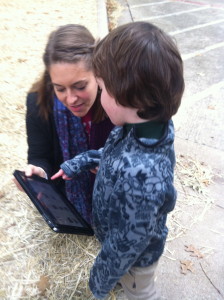
Recent Comments